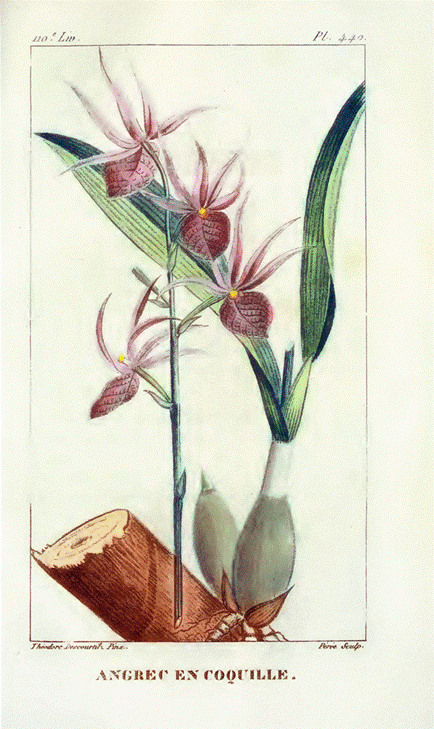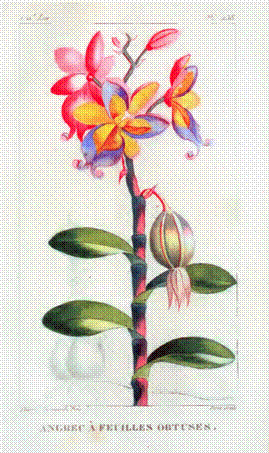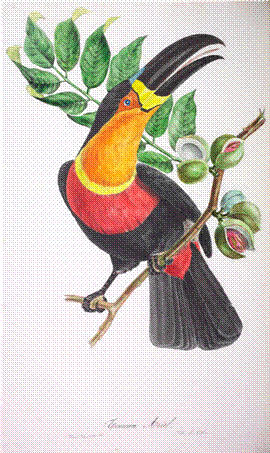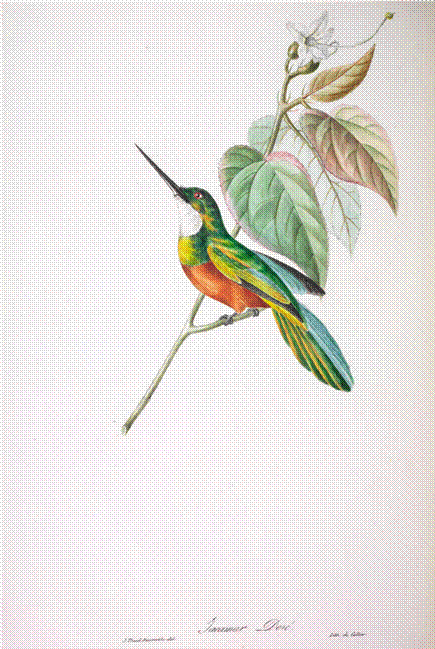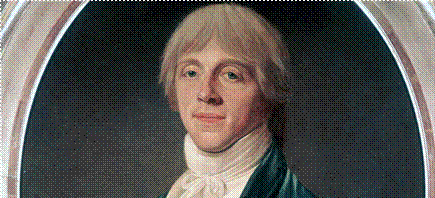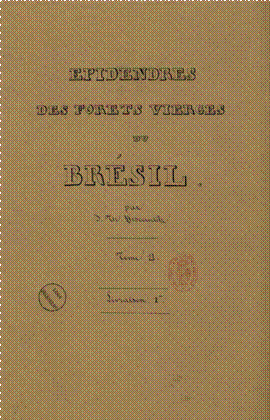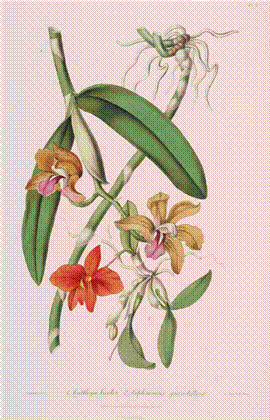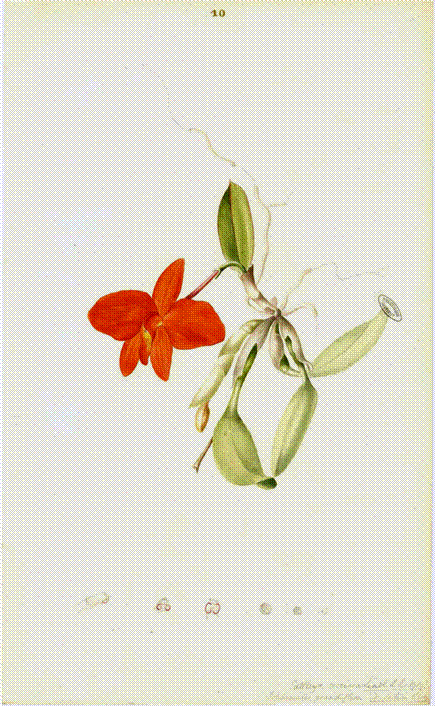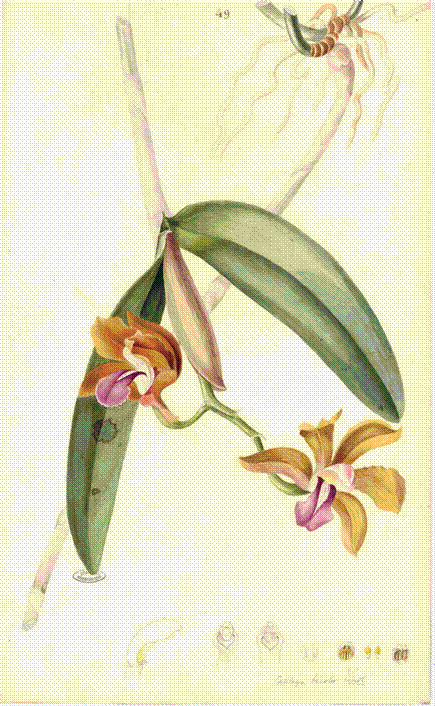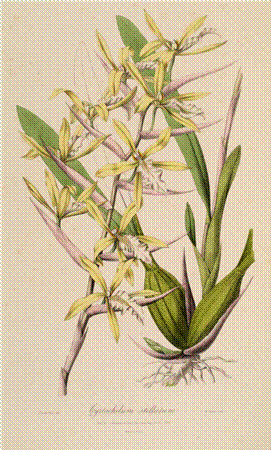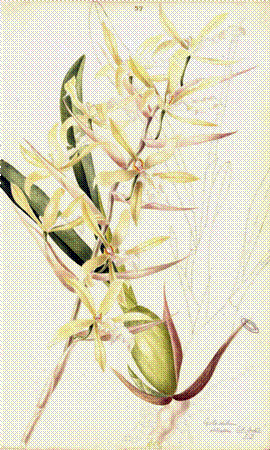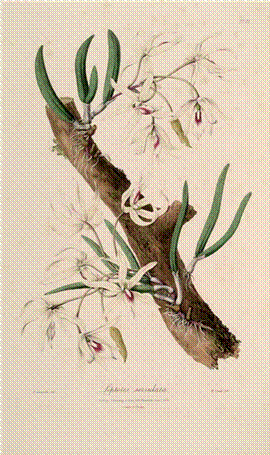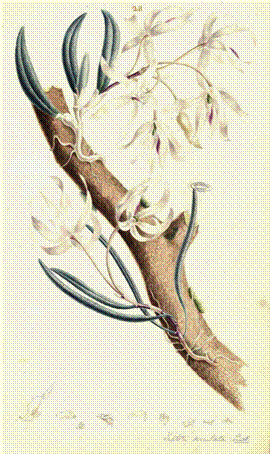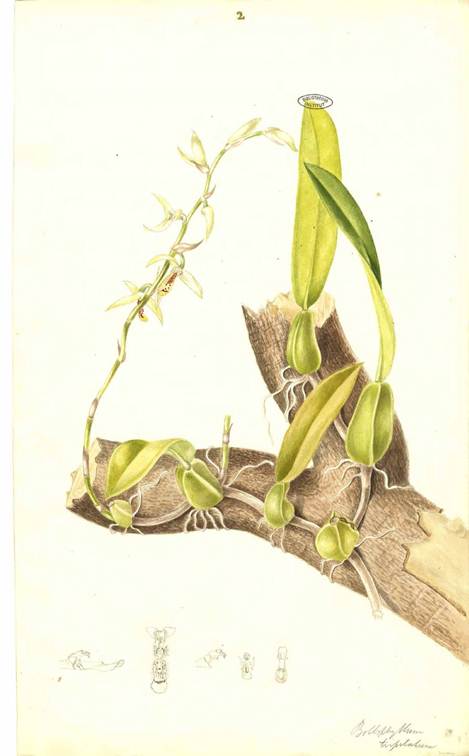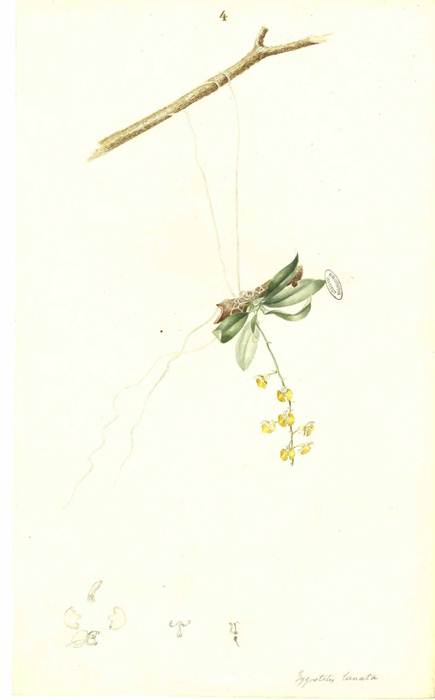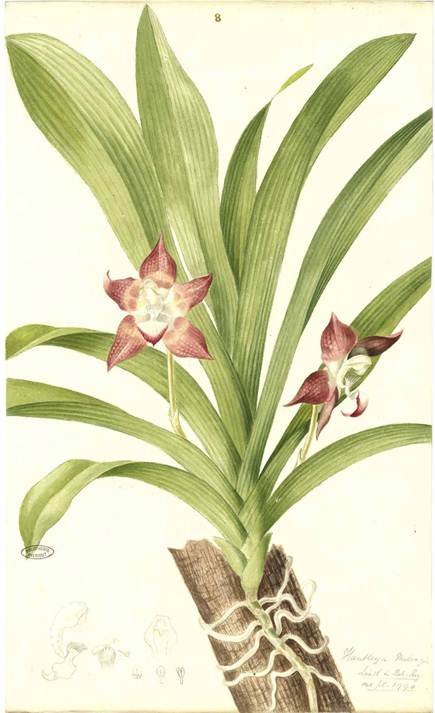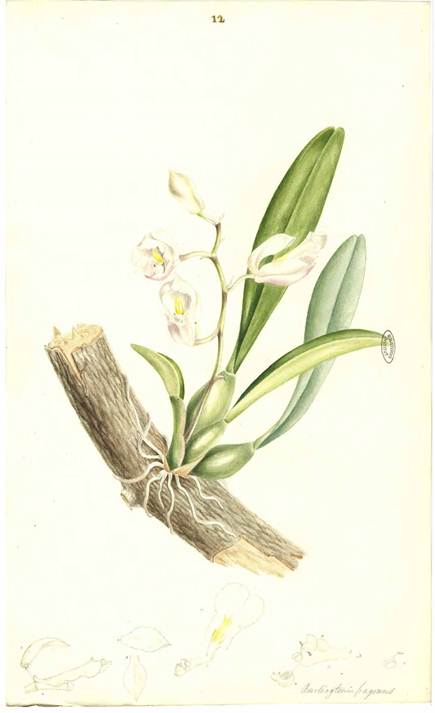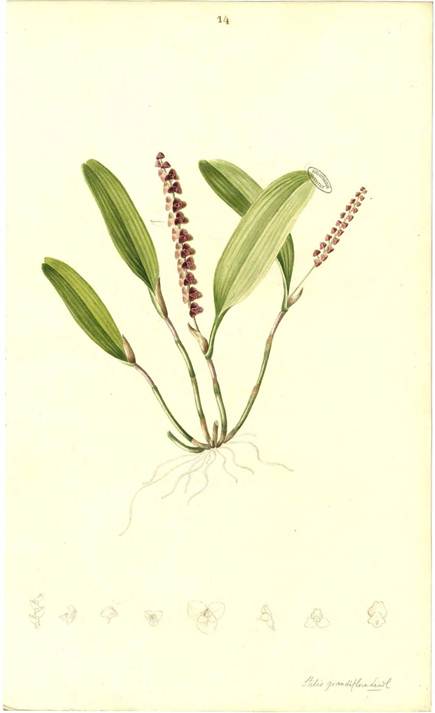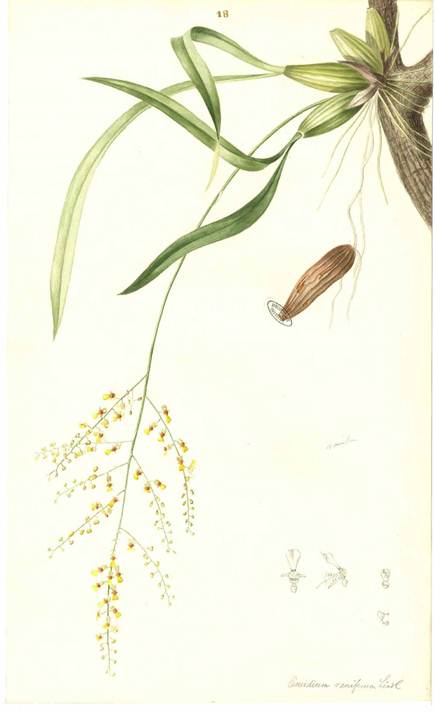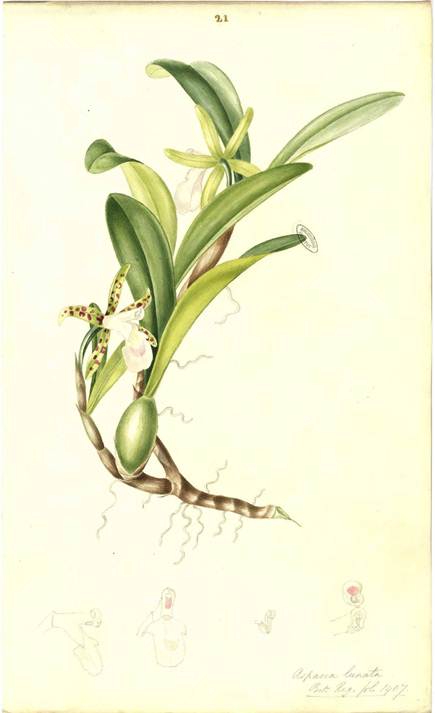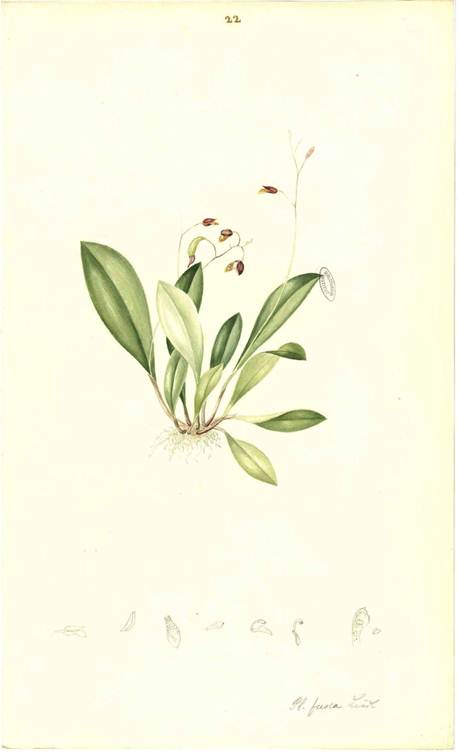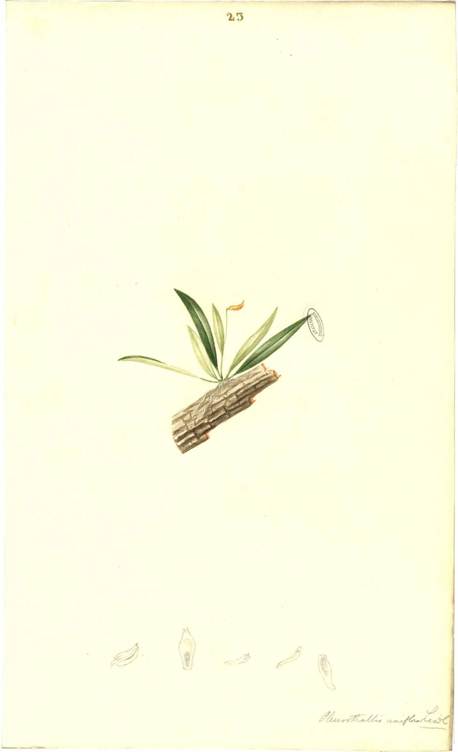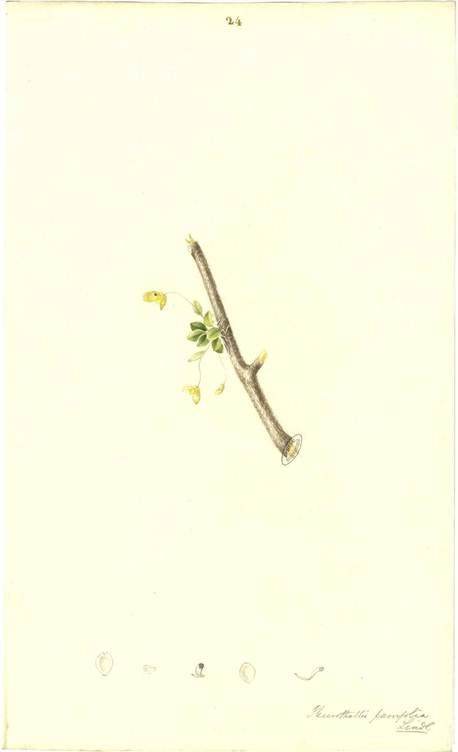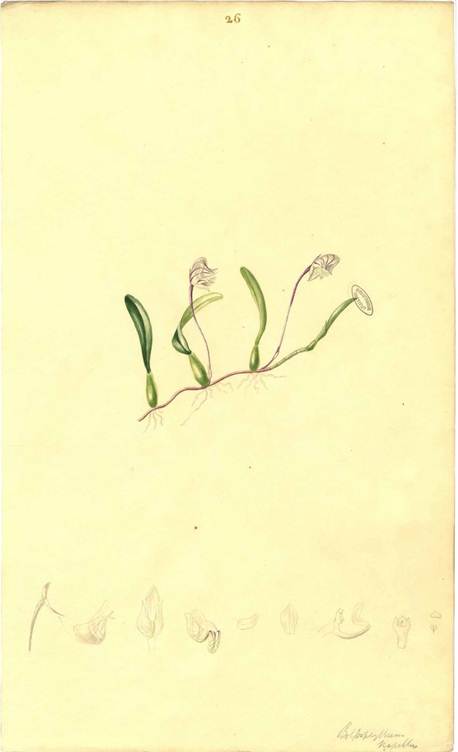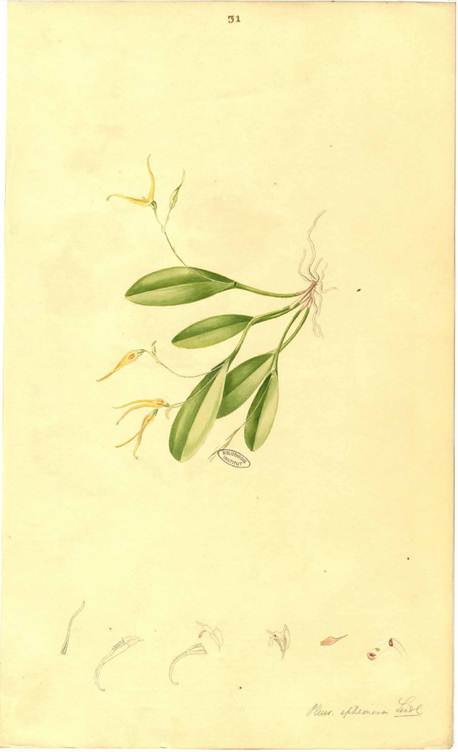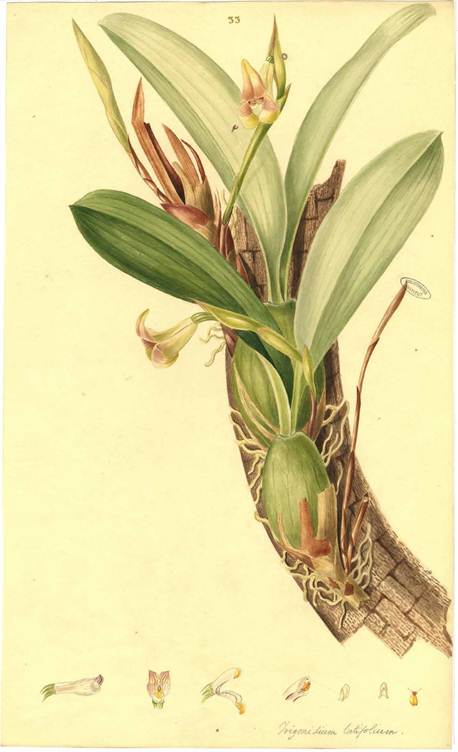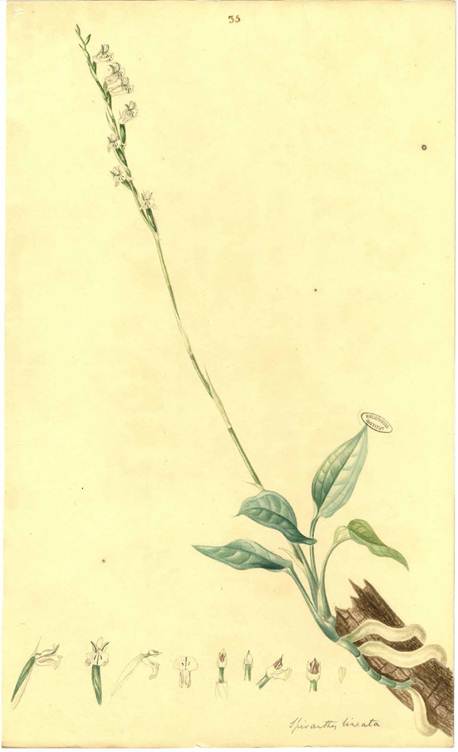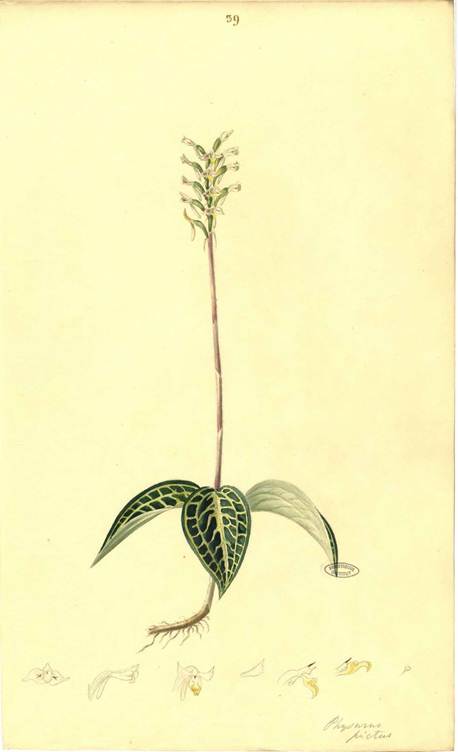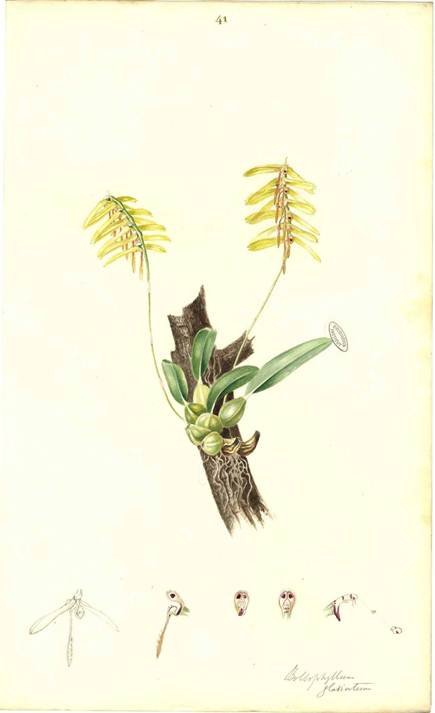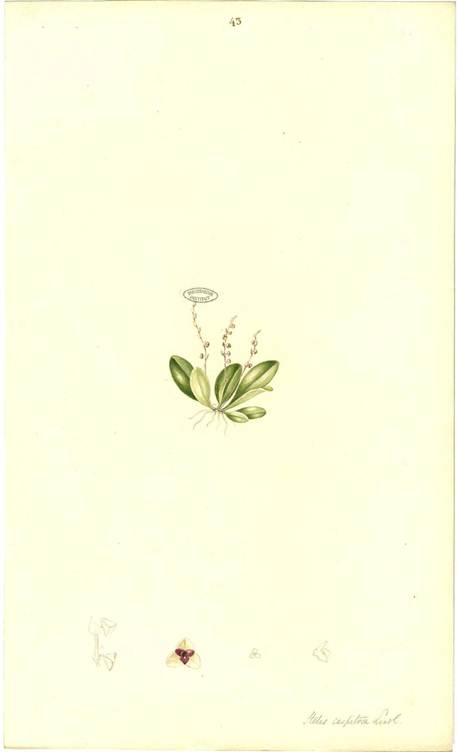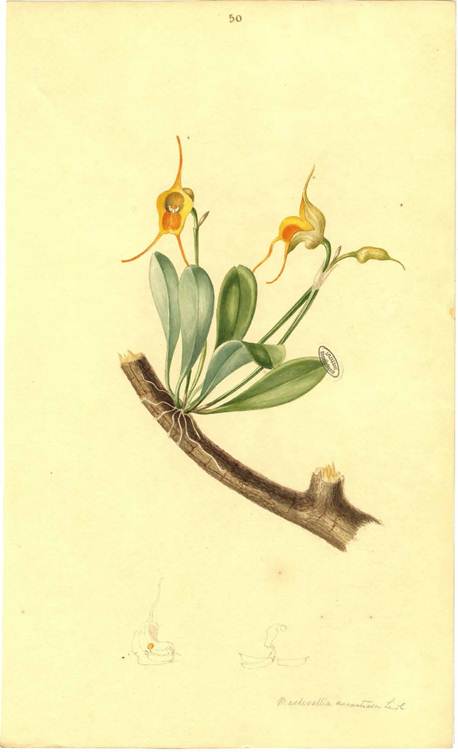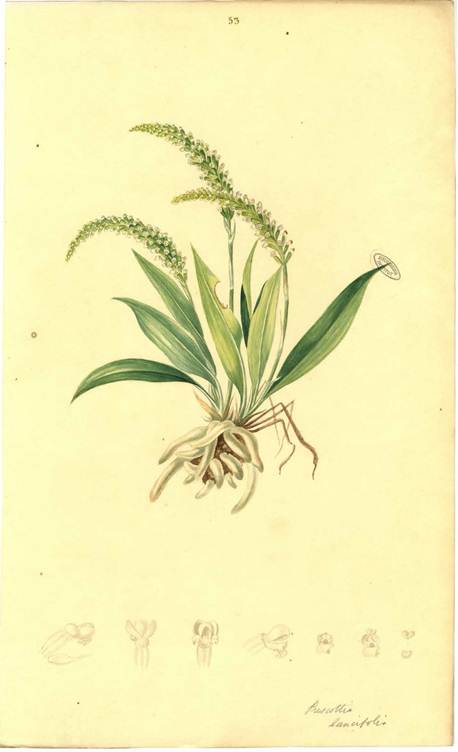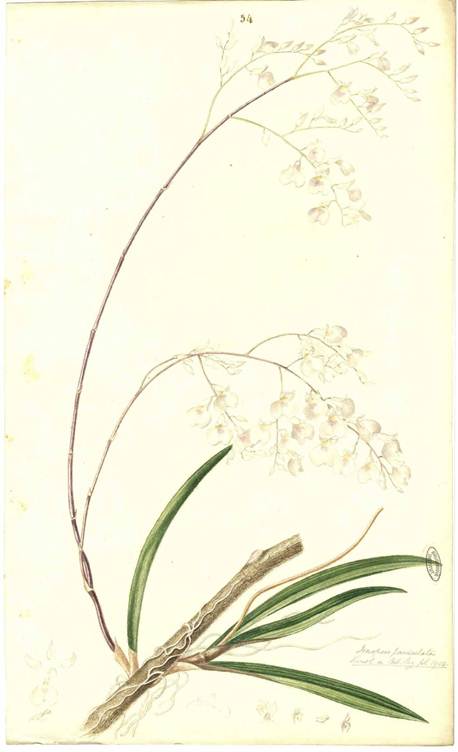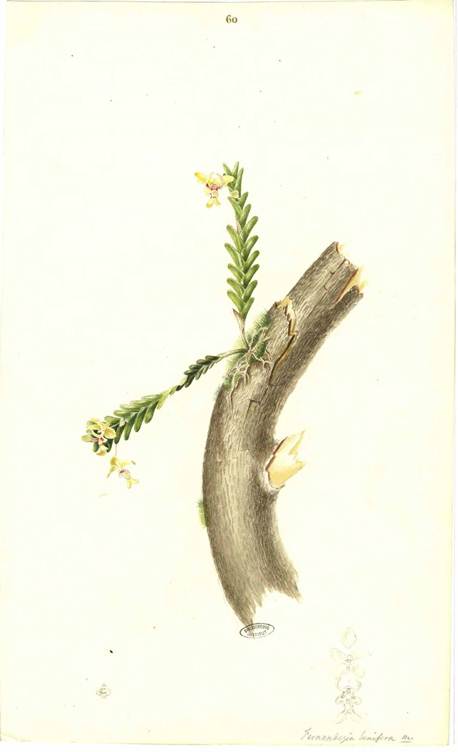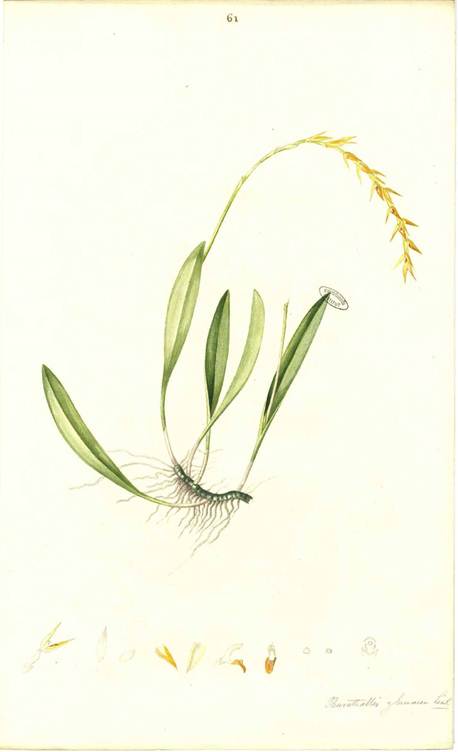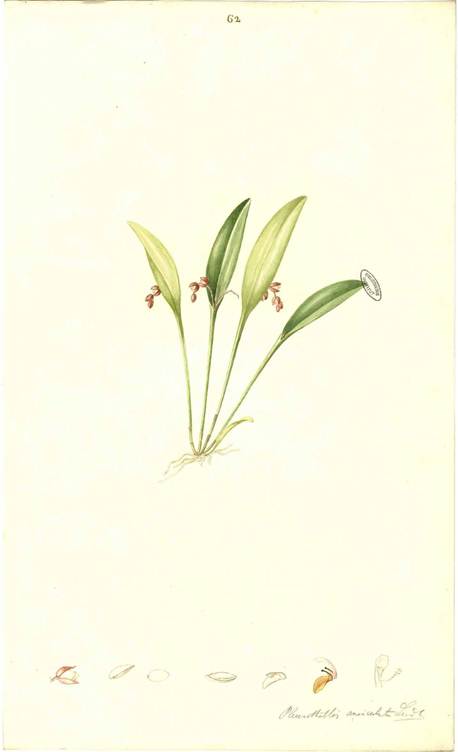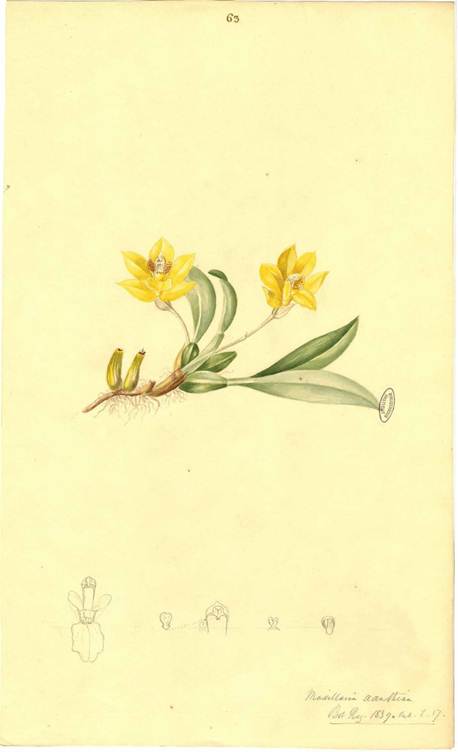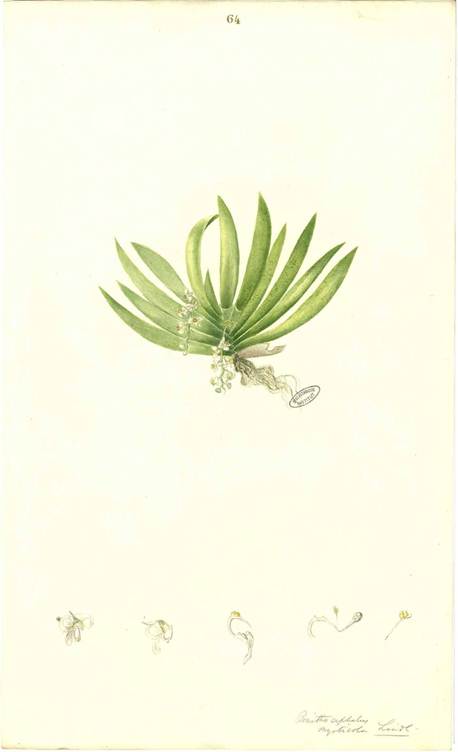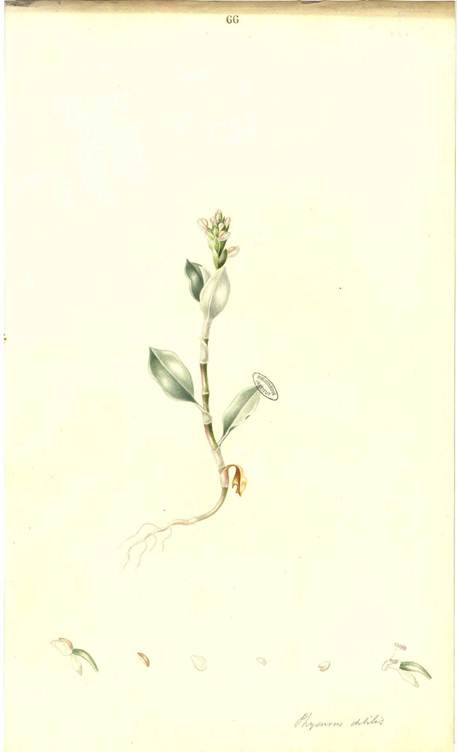The Descourtilz family in America
MiChaeletienne desCourtilz (1775-1835), after completing his medical studies, traveled to Charleston, South Carolina and Santiago de Cuba, arriving in Haiti on 2 April 1799. After many hardships during the slave revolts at the turn of the century, he was held captive for some time and finally obtained freedom after being liberated by a French Army column, leaving the island on “1 Prairial, an XI” of the revolutionary calendar (May 23, 1803). After his return to France, he worked as a physician in a hospital at Beaumont and served as president of the Paris Linnean Society. He never travelled to America again.
Descourtilz published Flore médicale des Antilles ou Traité des Plantes Usuelles des Colonies Francaises, Anglaises, Espagnoles et Portugaises (Medicinal Flora of the Antilles or Treatise of the usual plants of the French, English, Spanish and Portuguese colonies) between 1821 and 1829, illustrated by his son Jean théodore desCourtilz (1796-1855), a physician and botanist like his father. Five orchids were described and illustrated in this work.
The illustrations are of little botanical value. Grisebach went further and called them “a series of execrable chiefly copied drawings, […] of little or no scientific value” (Grisebach, 1859-64: vii) (Fig. 1-2). Looking at the illustrations, one must go along with Grisebach´s opinion, as Descourtilz’ illustrations lack detail.
Jean-Theodore Descourtilz travelled to South America, and arrived in Brazil in about 1826, since in 1831 his lavishly illustrated manuscript on the hummingbirds of São Paulo and Rio de Janeiro was acquired by the library of the National Museum. In this work, referring to a particular hummingbird, he states that it was a species so rare that in five years of research he collected only two specimens. Descourtilz was an interested and meticulous observer, concerned about the accuracy of his notes which concisely described the habits and appearance of each species. His poetic and flowery text was in keeping with the period, and was invariably accompanied by colour plates of the species studied. In 1834, his Oiseaux brillans du Brésil was published in Paris, again with magnificent watercolour illustrations (Figs. 3-4), so that one comes to doubt that they came from the same hand that had produced the “ execrable chiefly copied drawings” published ten years earlier and so harshly criticized by Grisebach.
A reason may be that Descourtilz Jr. was only description of the new Brazilian species, Bolbophyllum seven years old when his father returned from Haiti tripetalum (Lindl., Ann. Nat. Hist. vol. 10, p. 185), John and therefore never saw the Antillean orchids of Lindley cited the provenance of the type in this way: Wild which Descourtilz Sr. wrote with his own eyes. His in Brazil, in the province of St.Paul’s - Descourtilz - illustrations in the Flore des Antilles must have been (v. ic. pict. in bibl. De Lessert)1. This somewhat cryptic based either on herbarium specimens or perhaps on annotation can only be understood as that Lindley found sketches made in the field by his father. Another an illustration by Descourtilz of the plant now described possibility is that he never produced the illustrations as a new species. This is corroborated after further of the Flore des Antilles, and that they came from studying Lindley’s descriptions of other new Brazilian the hand of another artist, perhaps his father himself. species, when we read, in his description of Ionopsis Either way, the two sets of illustrations have little in common.
So far, Jean-Théodore Descourtilz had no apparent relation with the Brazilian orchid world, but around 1836 our story took and unexpected turn. At the end to the description of the new Brazilian species, Bolbophyllum tripetalum (Lindl., Ann. Nat. Hist. vol. 10, p. 185), John Lindley cited the provenance of the type in this way: Wild in Brazil, in the province of St.Paul’s - Descourtilz - (v. ic. pict. in bibl. De Lessert)1. This somewhat cryptic annotation can only be understood as that Lindley found an illustration by Descourtilz of the plant now described as a new species. This is corroborated after further studying Lindley’s descriptions of other new Brazilian species, when we read, in his description of Ionopsis paniculata: …a very remarkable species, with which I am acquainted through an extensive unpublished collection of excellent water-colour drawings, by Mons. Descourtilz, of Brazilian Orchideous plants, obligingly lent to me by Baron Delessert.
As life goes, the one responsible for execrable chiefly copied drawings produced now - one decade later - excellent water-colour drawings! And being Lindley a skilled illustrator himself, one must trust his judgement.
A parenthesis is here required to comment on baron Jules Paul benJaMin delessert (1773-1847) (Fig. 5). Born in Lyon in a wealthy family of bankers, he started many commercial enterprises, among them a sugar factory where the industrial manufacture of sugar from beet was developed, and for which he was named a ‘baron of the Empire’.
A strong advocate for many humane measures, the suppression of the death penalty, and the improvement of the penitentiary system, he was made regent of the Bank of France in 1802, and was also member of, and, indeed, founder of many, learned and philanthropic societies. He was also an ardent botanist and conchologist; his botanical library embraced 30,000 volumes, of which he published a catalogue, the Musée botanique de M. Delessert (1845). He bought specimens from famous herbaria, among them those from Humboldt and Bonpland, de Candolle, and Robert Brown, and at the time of his death his herbarium contained 250,000 sheets representing 85,000 different species. It is therefore no surprise to us that Descourtilz’ water-colours of Brazilian orchids fell somehow in his hands. It may even be that they were produced on a contract given by Delessert to Descourtilz.
Our search for a publication of Descourtilz’ drawings was fruitless, simply - as we soon found out - because they were never published. After a long search and with more than a bit of fool’s luck, we found, in the library of the Institut de France2, in Paris, an unpublished manuscript by Jean-Théodore Descourtilz, consisting of 83 water-colour illustrations of Brazilian orchids, and the corresponding explanatory texts detailing the structure and anatomy of the plants, their habitat, and their locality of collection. The manuscript carries the title: Epidendres des forêts vierges du Brésil (Epidendra from the virgin forests of Brazil) (Fig. 6) and attached to it are a few - almost unreadable notes and fragments of letters that give us an idea of the timeline.
The 3 volumes were received from M. Descourtilz by Delessert on Sept. 3rd 1832. Descourtilz was paid an advance of 300 P (?).
83 water-color designs were sent to Mr. Lindley plus one manuscript text through Mr. Percy on the 1st of May (?) of 1836 for determination.
The water-colours were returned to the heirs of M. Delessert on February 18, 1852 by way of Mr. Weddell3 (Delessert had died in 1847).
As we will see later, Lindley described quite a few new species based on Descourtilz’ drawings. In his descriptions, Lindley often mentioned the original French names given by Descourtilz to his species (using always the name Epidendre for all species, and never once using the family name Orchideae or Orchidaceae) and sometimes also the plate number used by Descourtilz. With no exception, both name and plate number coincide with the unpublished manuscript which we now have the possibility to study. The manuscript held at the Institut de France is the same that Delessert gave on loan to Lindley in 1836.
Probably the best proof for the quality of Descourtilz’ illustrations lies in Lindley’s publication of his Sertum Orchidaceum, a wreath of the most beautiful orchidaceous flowers (1838), one of his most applauded publications (Fig. 7, 10, 12). A book review (Anonymous, 1838: 148151) wrote about it: It is almost needless to add that, though the ‘Orchidaceae’ [Bateman’s work on Mexico and Guatemala] and the ‘Sertum’ are of not absolute perfection in regard to the execution of the plates, yet they are in every other respect so excellent, and in point of magnificence so far before all other works on the Orchidaceae, that they cannot fail to command the admiration of all botanists and patrons of botany…
And as we will see, Lindley’s admiration for Descourtilz’ illustrations went so far that in three plates of his Sertum he made almost exact copies of four plates of the Frenchman’s work (Fig. 8-9, 11, 13). In his description of Burlingtonia venusta in his Sertum, Lindley confessed: “This lovely flower is at present only known from a drawing made in Brazil by Mons. J. Th. Descourtilz and forming part of a manuscript description, with figures, of Orchidaceous plants now the property of M. le Baron Benjamin Delessert. As I have the permission of their liberal proprietor to publish such as are most remarkable in this collection, I shall have frequent occasion to avail myself of its materials, in illustration of the present work.”
New species among Descourtilz’ illustrations.
Perhaps the most important contribution of JeanThéodore Descourtilz to orchidology was the fact that Lindley described no less than 31 new species among the illustrations contained in the manuscript loaned to him by Baron Delessert. Among these we find five species’ descriptions in which Lindley mentions specimens by other collectors besides Descourtilz’ illustration of the plant, which must therefore be considered a syntype. The remaining 25 illustrations by Descourtilz are holotypes, since they constitute the sole basis for Lindley’s description (Table 1). The rest of the manuscript, 52 illustrations, corresponds to species already described by other authors at the time of the arrival of the manuscript in England, or to species which Lindley, for any reason whatsoever, was not able to determine (Fig. 14-41).
All these species were described by Lindley between 1836 - the year in which he received the document from Delessert Plate 49 - and 1842.
About Jean-Théodore Descourtilz as botanist, there is little to be said. A search through the main herbaria of the world that have digitalized catalogues shows - with the exception of Kew- nothing with regard to Descourtilz’ collecting activity. Even Delessert’s herbarium, now in Geneva, contains not a single specimen collected by Descourtilz. And even Kew shows only two obscure and badly prepared specimens of Huntleya meleagris and Plerothallis fusca, attributed to Descourtilz, and a pencil sketch of Trigonidium latifolium, supposedly by Robert Allan Rolfe, which is an exact copy of plate 33 of Descourtilz’ manuscript (Fig. 41).
Table 1 New orchid species described by Lindley among Descourtilz’ illustrations.
| Plate N° in MS | Name by Descourtilz | Type status | Location | Name by Lindley |
|---|---|---|---|---|
| 2 | Epidendre tripétale | Holotype | Bananal, São Paolo | Bolbophyllum tripetalum |
| 4 | Epidendre aerien | Holotype | Bananal, São Paolo | Zygostates lunata |
| 8 | Epidendre fritillé | Holotype | Rio de Pirapitinga, Bananal, São Paolo | Huntleya meleagris |
| 10 | Epidendre ponceau | Holotype | Bananal and Ilha Grande, São Paolo | Cattleya coccinea |
| 12 | Epidendre panduriforme | Syntype (+ Herb. von Martius s.n.)4 | Morro-Quemado, Macahé, Bom Jesus de Bananal / Martius: s.loc. | Burlingtonia fragrans |
| 14 | Epidendre heteracé | Holotype | ‘Tout le Brésil’ | Stelis grandiflora |
| 18 | Epidendre graminé | Syntype (+ Gardner 637)5 | Bananal, São Paolo / Gardner: Organ Mountains | Oncidium raniferum |
| 21 | Epidendre tricolore | Holotype | Bananal, São Paolo | Aspasia lunata |
| 22 | Epidendre bilabié-tigré | Holotype | ‘Toute la zone elevé du Brésil’ | Pleurothallis fusca |
| 23 | Epidendre bilabié-ligulé | Holotype | Haut Macahé and Bananal | Pleurothallis uniflora |
| 24 | Epidendre bilabié- lemnoide | Holotype | ‘Toute les districts du Brésil eloignés des côtes’ | Pleurothallis parvifolia |
| 26 | Epidendre napel | Syntype (+ Miers s.n.)6 | Route du Bananal à Ilha Grande / Miers: Brazil | Bolbophyllum napelli |
| 28 | Epidendre ficoïde | Holotype | Haute Macahé, Ilha Grande | Leptotes serrulata |
| 31 | Epidendre ephêmère | Holotype | s. loc. | Pleurothallis ephemera |
| 33 | Epidendre à chainons | Holotype | Montagnes de la Bucahna, bois de la Parahyba, Rezende | Trigonidium latifolium |
| 35 | Epidendre spiral | Syntype (+ Herb. von Martius s.n.) | Rezende / Martius: Brazil | Spiranthes lineata |
| 37 | Epidendre étoilé | Holotype | Macahé, Bananal | Cyrtochilum stellatum |
| 39 | Epidendre peint | Holotype | Ilha Grande | Physurus pictus |
| 41 | Epidendre porte-glaive | Holotype | Bananal, São Paolo | Bolbophyllum gladiatum |
| 43 | Epidendre delicat | Holotype | s. loc. | Stelis caespitosa |
| 49 | Epidendre irideé | Holotype | Bananal, São Paolo | Cattleya bicolor |
| 50 | Epidendre cirrhifère-aurore | Holotype | Haute Macahé | Masdevallia aurantiaca |
| 51 | Epidendre cirrhifère-tricolor | Holotype | Bananal, São Paolo | Masdevallia tridentata |
| 53 | Epidendre miliaire | Syntype (+ Gardner 681) | Ilha Grande / Gardner: idem | Prescottia lancifolia |
| 54 | Epidendre paniculé | Holotype | São Paolo | Ionopsis paniculata |
| 60 | Epidendre antropomorphe | Holotype | Bananal, São Paolo | Fernandezia lunifera |
| 61 | Epidendre porte-glume | Holotype | Rio de Pirahy | Pleurothallis glumacea |
| 62 | Epidendre auriculé | Holotype | Fleuve Macahé | Pleurothallis auriculata |
| 63 | Epidendre jonquille | Syntype (+ Gardner 652) | Ilha Grande / Gardner: Organ Mountains | Maxillaria xanthina |
| 64 | Epidendre bec-d’oiseaux | Holotype | Bom Jesus de Bananal | Ornithocephalus myrticola |
| 66 | Epidendre amaranthe | Syntype (+ Prescott s.n.)7 | Fazenda du Lumiar, district du Haute Macabé / Prescott: s. loc. | Physurus debilis |
6Carl Friedrich Philipp von Martius (1794-1868)
7George Gardner (1812-1849)
8John Miers (1789-1879)
9John D. Prescott (?-1837)
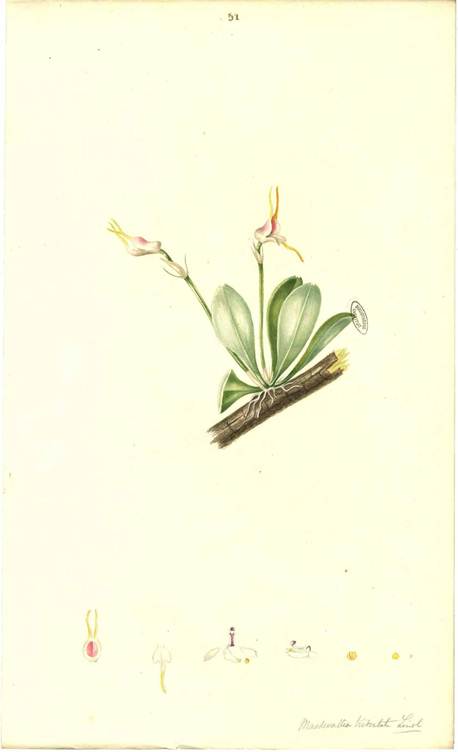
Figure 32 Descourtilz’ manuscript. Plate 51: Epidendre cirrhifère-tricolor - Masdevallia tridentate.
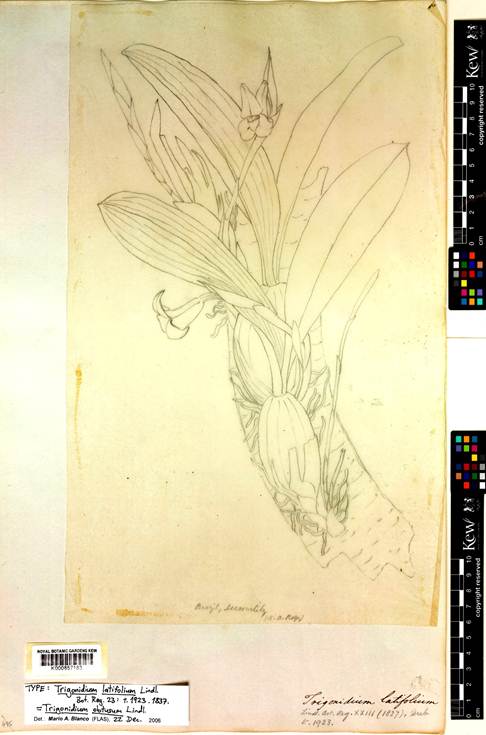
Figure 41 Pencil copy supposedly by Robert A.Rolfe of plate 33 in Decourtilz manuscript, in Kew under number K000857183.
In the late 1840s or early 1850s, Descourtilz was sent by the Brazilian Government to the province of Espírito Santo, the north-east of Rio de Janeiro, to investigate the animal life and to report on precious minerals. He discovered traces of gold and iron in the vicinity of the village Laurinha, created by the provincial government to house and proselytize the Puri Indians. However, the ill-treatment suffered by the Indians drove them away and led to the decay of the village. At the site there was a village that eventually became the city of Conceição do Castelo on the headwaters of the Rio Castelo, a tributary of the Itapemirim. Descourtilz explored the city of Itapemirim and nearby towns, gathering various minerals and a collection of crystals, all lodged with the National Museum of Rio de Janeiro, where he took up an appointment in 1854.
Descourtilz was a member of the Société Linnéenne de Paris and of the Société Auxiliaire de l’Industrie de Rio de Janeiro. He died of arsenic poisoning caused by chemicals he used in the preparation of specimens.
From the geographical point of view, it seems clear that Jean-Théodore Descourtilz produced most of his scientific work -biological, geological and otherwise- along the coastal strip covered by the adjoining provinces of Espírito Santo, Rio de Janeiro and São Paolo.












 uBio
uBio 
